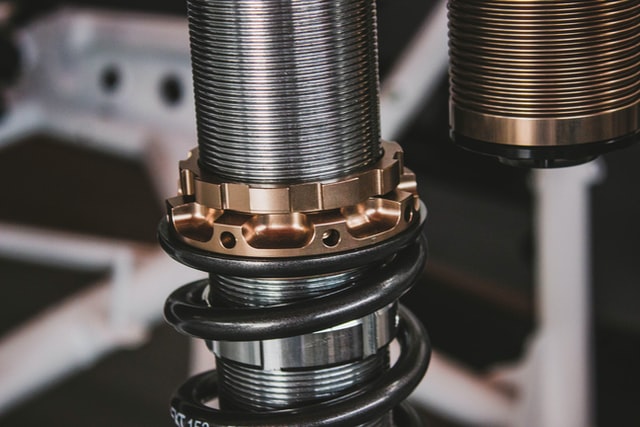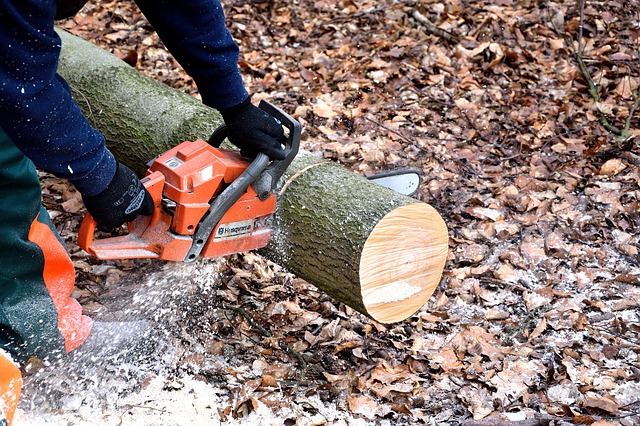This snippet has been taken from “Homeowner’s Complete Guide To The Chainsaw” By “Brian J. Ruth & Jen W. Ruth”. Manual Sharpening of Chainsaws will touch up a chain and keep it sharper than new literally a hundred times. “Emergency Tree Removal Service” explains this process in details.
1. Secures the saw. Secure the saw bar in a vise so you have access to the chain and it can still move. Here, the vise is a portable stump vise that is hammered into the end grain of a stump.

2 Clean dust and debris from chain.
Clean any dust or debris out of the chain wit6h a small bristle brush. Rotate the chain as you clean.
3 Pick starting point.
Find the smallest or most damaged cutter as your starting point. Mark the starting point. Clearly mark that, chalk, or felt-tip marker so you know where you started.
4 Secure the file handle.
Mount and secure the handle on the round file. For a wooden handle, force the handle over the tang of the file and tap with a mallet.
5 Put file in filing gauge. Slide or clip the round file into the filing gauge.
6 Determine filing angle.
Check with your, or thirty-five degrees) and align the mark (here thirty degrees) so that it is parallel with the guide bar and chain.
7 Holding the file guide.

Hold the file guide at a ninety-degree angle to the flat face of the saw bar. Some manufacturers specify holding the guide ten degrees down from square at the file handle. This type of file guide is designed to ride on the cutter and the depth gauge.
8 File from inside to outside.
File from the inside of the cutters while maintaining the correct angle throughout the stroke. Apply pressure on the forward stroke only. Continue filing (usually two to five strokes) until the top cutting edge is clean and sharp and the smooth chromed edge of the cutter extends to the top and the side plate cutting edges.
9 Sharpen, measure each cutter.
This cutter tooth is now your marker, and you can use a caliper to check that the others are filed the same. After each cutter has been sharpened, move the chain forward and sharpen the next cutter on that side. When you reach your marked cutter, move to the other side of the chain to sharpen that side’s cutters as well. Keep all cutters uniform.
10 Check chain’s depth gauge.
As cutters are filed back, their height is diminished in relation to the depth gauges. The depth gauges must be checked every three or four sharpening. If they are too high, the chain will not bite easily. Follow the manufacturer’s recommendation for correct depth gauge setting. Never over-file depth gauges, as this can lead to kickback!
11 Using the gauge tool.
Place the depth gauge tool over at least two cutters. Make sure the depth gauge on the chain enters the slot of the depth gauge tool. If the depth gauge protrudes, it is too high and needs to be filed down.
12 Filing the depth gauge.
Using a flat file mid level strokes, file the depth gauge3 down to the level of the depth gauge tool. Use flat6 forward strokes from the inside out.
13 Round the depth gauge.
Use the depth range tool to protect the sharpened cutter while in round off the front comer of the depth gauge in the flat file. Continue to file and round all their gauges.
Filing the cutters and depth gauges
Sharpening the cutting edges
Turn the chain-tension screw clockwise until the chain is tight and rigid. Lay the file guide horizontally across the top of the chain so that the file fits against a cutter’s curved, beveled cutting edge, and the top plate and the depth gauge support the guide. Align the appropriate angle-marker line with the edge of the guide bar and push steadily forward, applying moderate pressure against the cutting edge. Repeat the same forward stroke two or three times. Do not apply pressure to the cutting edge on the return stroke.
File all of the cutters that have similarly angled cutting edges-every other cutter on the chain. Then, switch the angle of the file guide and go on to file the remaining cutters.
Filing the depth gauges
Check the depth gauge on each cutter after you have sharpened its cutting edge. Set the depth gauge tool over the top of the chain as shown, the back edge of its grooved toe butting against the inside edge of the depth gauge. If the depth gauge protrudes, hold a single-cut mill file horizontal and perpendicular to the chain and push the file lightly across the top of the depth gauge. Lift the file and return it to the starting position. Do not pull the file back across the metal edge. Continue filing until the top edge of the depth gauge is level with the surface of the depth gauge tool. Remove the tool and round off the outer corner of the depth gauge with a few light strokes, again filing only on the forward stroke.
Continue reading on Removing your lawn